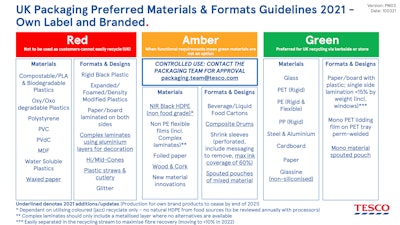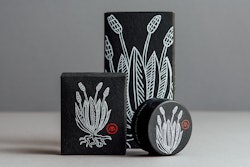
Paul Ernshaw, Technical Packaging Manager at Tesco, said his day job is to try to help save the planet, and urged attendees of the Sustainability in Packaging Europe conference in Barcelona to get on board too.
Speaking about both Tesco-brand products and brand-name products sold throughout the retailer’s thousands of outlets, Ernshaw said Tesco’s ambition for packaging is, “every material we use is either going to be reused or is going to be easily recyclable. We're going to use recycled materials wherever possible, and we are going to be the most helpful retailer for recycling and reuse.”
According to Tesco’s website, “Our 4Rs packaging strategy is to Remove where we can, Reduce where we can’t, Reuse more, and Recycle what’s left.” And as Ernshaw said, “The best thing to do to make your packaging sustainable is to remove it. If you can get rid of it, if it doesn't have a functional purpose, it should not be there. Once you've got rid of all the extra packaging that's not needed, the next thing you have to do is make what is left smaller, lighter, use less of it. That's the reduce.” Reuse, one of the more challenging “R” strategies, is also one of the most important for impact on carbon footprint, and finally recyclability is the last strategy to look at.
Ernshaw said there is a huge amount of pressure to do something about plastic waste and pollution, and this comes from consumers, the media, and government. Tesco has targets in place to address these issues:
· Tesco-brand paper and cardboard is to be sustainably sourced by March 2021, and this goal has already been accomplished. Brands to meet goal by end of 2022.
· Last year Tesco had another goal which it reached – to rid a billion pieces of plastic from its portfolio. This year an additional half billion pieces of plastic is to be removed.
· Following a successful trial of collection points that allowed customers to return previously unrecycled soft plastic, such as the clear film used to wrap meat and fish, crisp packets, fruit and vegetable bags, and sweets wrappers, Tesco is rolling the soft plastics collection points out to approximately 800 large stores. Soft Plastics Collection Points to be Rolled out in 800 StoresTesco
Soft Plastics Collection Points to be Rolled out in 800 StoresTesco
· All Tesco-label packaging is going to be reusable or recyclable at curbside and/or in large stores in the UK, by the end of this year. Brands aren’t yet held to this target, but Ernshaw said that eventuality is coming.
· External targets such as the UK plastic packaging tax for materials that aren’t at least 30% recycled content (which begins in April 2022), and the extended producer responsibility (EPR) program that begins in 2023.
Ernshaw said of these legislations, “It is going to drive us all to make better packaging decisions…please engage with those targets and the taxes. They are the right thing to do to help save the planet.”
Tesco provides a preferred materials list to its suppliers which consists of red, amber, and green designated materials, and another target mentioned by Ernshaw is to exit “red materials” for own-label by Christmas this year, and brands by 2022.
To further explain these categories, Ernshaw said, “We've thought about all the different types of packaging, materials, and formats, and we've put them into one of three categories. The red category is the naughty one. These are the ones that are not recyclable or are bad for the environment. You need to get out of those. You will not be allowed to sell in Tesco, if you are using any red materials or formats. The green are the ones that we prefer. These are what we want you to be in. They are recyclable, the lower impact. And then we have the amber, and these are the ones we don't like but for various technical reasons, we have to keep using them until we can find an alternative. If you are using an amber material and you want to sell it through Tesco, you are going to have to come to us and explain why it is necessary that you use it, and also present your plan for getting out of it.” About the guidance (there is a 144-page document available through Tesco), Ernshaw also added, “We kind of want that to be the textbook of how to do packaging sustainability.” Tesco's 2021 Preferred Materials and Formats for UK PackagingTesco
Tesco's 2021 Preferred Materials and Formats for UK PackagingTesco
Compostable Plastics
Tesco has banned compostable and biodegradable plastics. Compostable plastic is broken into two categories, home and industrial. Ernshaw said that home compostable is theoretically good because it will break down on a compost heap, but, he adds, only about 5% of people in the UK have a compost heap to begin with, and of those that do, most people will not put plastic on a compost heap.
Industrially compostable plastics do not break down unless subjected to certain conditions such as higher temperature and certain atmospheres. Ernshaw said, “An MRF near me, a recycler, says, "If we have one compostable bottle mixed in with a thousand ordinary PET bottles that we were going to recycle, instead of recycling them, they ship the whole lot into landfill now, because you've put a compostable plastic in there. It gets worse than that though. When these compostable plastics end up in landfill, they break down and they tend to give off methane. Ordinary plastic in landfill just sort of sits there being plastic and just doesn't do anything at all. It's inert. These break down and give off methane. Methane is 16 times more potent as a greenhouse gas than is carbon.”
Tesco has other considerations like preferring recycled paper and corrugate, and preferably paper and corrugate that has come from FSC or PEFC forests. Foil blocking will likely be replaced by metallic ink, and the company frowns on alternative materials such as bamboo.
 | Watch this video on Mars transition from plastic Smarties wrap to paper. |
Supply Chain
Ernshaw sums up Tesco’s approach as, “in the real world, our packaging must have the highest probability of delivering a positive outcome. We've made our material out of a nice green material, we made it recyclable, we sourced it properly, then we need to ship and sell it efficiently. We have a complicated supply chain with containers, and lorries, and pallets. And we've calculated that about 85% of our (own-brand) pallets are not efficient. About 15% air on average is what is on those pallets. That equates to 36,000 lorry journeys being wasted. If we could just get our pallets a little bit more efficient, then that would save the number of lorry journeys. If we put brands into it, I reckon it's about 90,000 lorry journeys a year. It's the boring end of sustainability, but it is something we're addressing. End-to-end efficiency is super important. We don't sell air and we don't package air.”
Future Proof Packaging and System Challenges
“There are three top tips for future proofing your packaging,” said Ernshaw. “First one is, address each stage of that packaging life cycle. Try and use mono materials wherever you can. Try and avoid exotic materials. And if you think there's a better way of doing it, then please tell us because we can then amend it. It's our responsibility as a big retailer to try and lead what is going on. We need to collaborate on this. And then, remember the customer. As soon as you start making things difficult for the customer, they won't do it. It's got to be simple.”
Addressing the subject of reuse systems, he said that “We are going to have to come up with reuse systems that make it easy for customers to reuse. We've all got into the habit of taking our bags into store now. We've done it there. How are we going to make it work on the other things?” But issues exist such as the additional labor needed to monitor and clean reuse stations. “We haven't cracked it yet, but it is an area of huge focus,” he said.
And finally, said Ernshaw, “The recycling infrastructure is the major problem at the moment. Which is why we are having to collect soft plastic in store, because that's a big hole in the recycling infrastructure. We are stepping in to do it for them. But ideally, it should be collected at curbside.”
 | Listen to this podcast on 10 Billion Reasons to Embrace Reusable Packaging. |
Interested in Learning More About Sustainable Packaging? Download Our Free PDF: 'Getting Started with Sustainable Packaging' Below.






















